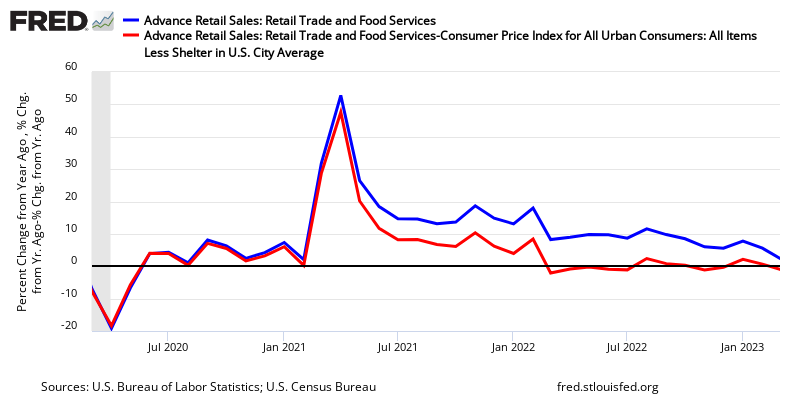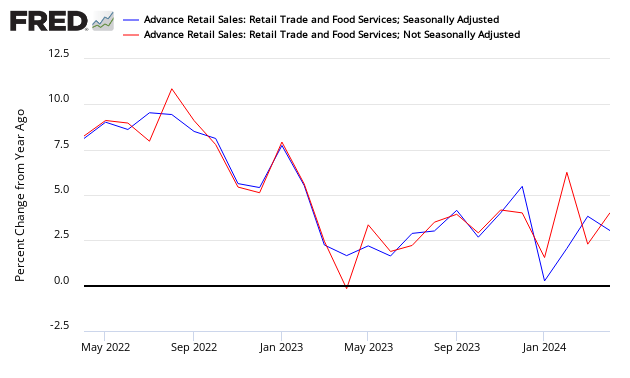Headline Retail Sales Decline In November 2020
Retail sales modestly declined according to US Census headline data. The three-month rolling average improved. Year-over-Year growth remains in positive territory

Analyst Opinion of Retail Sales
Retail sales have fully recovered their pre-virus levels overall. However, there is still year-over-year weakness in restaurants, department stores, clothing stores and gas stations.
There was a downward adjustment to last month's data. The real test of strength is the rolling averages which modestly improved. Overall, this report is considered weaker than last month.
Please consider that this data is not adjusted for inflation.
Econintersect Analysis:
- the unadjusted sales rate of growth decelerated 3.3 % month-over-month, and up 2.5 % year-over-year.
- unadjusted sales 3-month rolling year-over-year average growth accelerated 0.5 % month-over-month, up 5.4 % year-over-year.
- unadjusted sales (but inflation-adjusted) up 1.7 % year-over-year
- this is an advance report. Please see the caveats section below which shows variations between the advance report and the "final".
- in the seasonally adjusted data - the weaknesses were widespread.
U.S. Census Headline Analysis:
- seasonally adjusted sales down 1.1 % month-over-month, up 4.1 % year-over-year (published up 5.7 % YoY last month).
- the market was expecting (from Econoday):
| seasonally adjusted | Consensus Range | Consensus | Actual |
| Retail Sales - M/M change | -0.8 % to 0.2 % | -0.3 % | -1.1 % |
| Retail Sales less autos - M/M change | -0.5 % to 0.4 % | 0.1 % | -0.9 % |
| Less Autos & Gas - M/M Change | -0.5 % to 0.3 % | 0.2 % | -0.8 % |
| Control Group - M/M change | -0.3 % to 0.5 % | 0.2 % | -0.5 % |
Year-over-Year Change - Unadjusted Retail Sales (blue line) and Inflation-Adjusted Retail Sales (red line)
Retail sales per capita is back to pre-pandemic levels - see graph below.
Year-over-Year Percent Change - Per Capita Seasonally Adjusted Retail Sales
From the U.S. Census Bureau press release:
Advance estimates of U.S. retail and food services sales for November 2020, adjusted for seasonal variation and holiday and trading-day differences, but not for price changes, were $546.5 billion, a decrease of 1.1 percent (±0.5 percent) from the previous month, but 4.1 percent (±0.7 percent) above November 2019. Total sales for the September 2020 through November 2020 period were up 5.2 percent (±0.5 percent) from the same period a year ago. The September 2020 to October 2020 percent change was revised from up 0.3 percent (±0.5 percent)* to down 0.1 percent (±0.2 percent)*. Retail trade sales were down 0.8 percent (±0.5 percent) from October 2020, but 7.1 percent (±0.7 percent) above last year. Nonstore retailers were up 29.2 percent (±1.6 percent) from November 2019, while food services and drinking places were down 17.2 percent (±3.7 percent) from last year
Seasonally Adjusted Retail Sales - All (red line), All except food services (blue line), and All except motor vehicles (green line)
The differences between the headlines and Econintersect are due to different approaches to seasonal adjustment (see caveats at the end of this post).
Comparison of the Year-over-Year Census Seasonally Adjusted Retail Sales (blue line) and Econintersect's Unadjusted Retail Sales (red line)
Declines of short duration often occur in the seasonally adjusted series without a recession resulting.
Retail and Food Services Sales - Seasonally Adjusted
And finally, as retail sales can be a component of determining a recession start date, the zero-line of the graph below could be an indicator a recession was underway (or about to begin).
Retail Sales - Recession Watch Graph
Caveats On Advance Retail Sales
This data release is based on estimates. However, the estimates have proven to be fairly accurate although tend to miss at economic turning points. Therefore up to three months are subject to backward revisions, although normally slight, can sometimes be modest.
The data in this series is not inflation-adjusted - and Econintersect adjusts using CPI less shelter CUSR0000SA0L2. The St. Louis Fed also inflation adjusts the Census seasonally adjusted data. The last two recessions began as the inflation-adjusted retail sales crossed the zero growth line.
Comparison of Real Year-over-Year Growth between FRED's Real Retail Sales (green line) and Econintersect's Inflation Adjusted Retail Sales
As in most US Census reports, Econintersect does not agree with the seasonal adjustment methodology used and provides an alternate analysis. The issue is that the exceptionally large recession and the subsequent economic roller coaster has caused data distortions that become exaggerated when the seasonal adjustment methodology uses more than one year's worth of data. Further, Econintersect believes there is a New Normal seasonality. Using data prior to the end of the recession for seasonal analysis could provide the wrong conclusion.
The impact of the monthly retail sales data on GDP is not straight forward. Real GDP (of which the consumer is over 60%) is adjusted for inflation. Further, GDP is an analysis of quarter-over-quarter or year-over-year growth, while retail sales is a monthly data series.
Econintersect determines the month-over-month change by subtracting the current month's year-over-year change from the previous month's year-over-year change.
Disclaimer: No content is to be construed as investment advise and all content is provided for informational purposes only.The reader is solely responsible for determining whether any investment, ...
more











